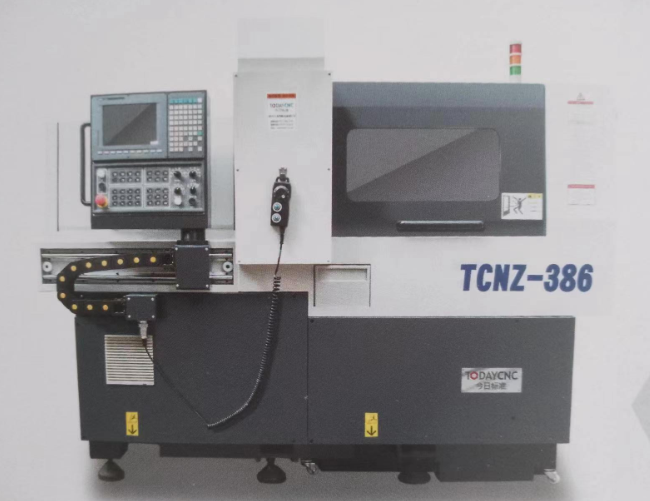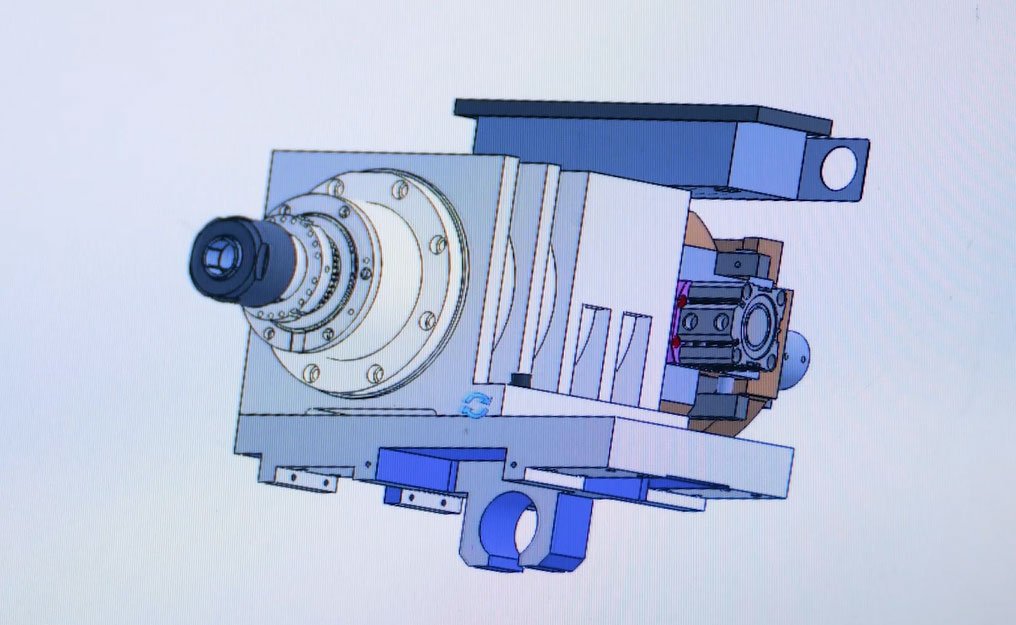In order to achieve certain motion functions of machine tools, the components are combined by connecting surfaces. The connection surface is divided into fixed connection surface (such as bolt connection), semi-fixed connection surface (such as friction clutch) and moving connection surface (such as sliding guide rail, rolling guide rail). Since the connection surface has contact stiffness and contact damping, there is a very close relationship between the connection surface and the static and dynamic characteristics of the machine tool. The influence of the connection surface cannot be ignored for the design of high-precision machine tools. Therefore, it is particularly necessary to analyze the performance of the machine tool joint surface and study the relationship between the joint surface performance and the overall machine tool performance.
Slide rail connection is one of the common forms of kinematic connection surfaces in machine tools. Many scholars have conducted research and analysis on the machine tool slide rail connection surface. HUSEYIN FILI and others used a two-dimensional slide rail model to simplify the slide rail structure. They used the finite element method to calculate the static displacement field of the rectangular slide rail and the triangular slide rail, and obtained the deformation and load distribution of the slide rail connection surface. Zhang Guangpeng et al. studied the modeling and analysis method of the dynamic characteristics of the guide rail joint based on the dynamic basic characteristic parameters of the joint surface. Zhang Xueliang established a fractal model of the contact stiffness of the mechanical joint surface based on fractal theory. Wang Shijun et al. proposed a finite element method for simulation analysis of machine tool guide rail joint characteristics based on the joint surface characteristic parameters. Wang Weiyou analyzed the main factors affecting the dynamic performance of sliding rails and determined the content and methods of dynamic test research on sliding rails. The above-mentioned research focuses on the equivalent treatment, calculation and experimental extraction of performance parameters of the slide rail connection part, and lacks research on the performance analysis of the slide rail connection surface.
This paper performs static performance calculations on the slide rail connecting surfaces of two sliding cross-section configurations, analyzes the displacement characteristics of the slide rail connecting surfaces, and finds out the relationship between the joint surface stiffness and the machine tool stiffness from the displacement characteristics of the connecting surfaces. Provides the basis for joint surface design.
1 Slide rail connection cross-section configuration
The function of the machine tool slide rail is to guide and carry, guide the moving parts to move accurately along a certain trajectory, and bear the weight and cutting force of the moving parts and their upper mounting parts.
The cross-sectional configuration of the slide rail connection refers to the different shapes on the longitudinal cross section of the slide rail. There are many different configurations of machine tool slide rail connection surfaces. Commonly used ones include rectangular slide rails, triangular slide rails and dovetail slide rails, as shown in Table 1.
2 Finite element static calculation
In order to analyze the static performance of different slide rail cross-section configurations and their impact on machine tool performance, this article uses the finite element method, taking a flat bed CNC lathe as an example, to analyze the static performance of rectangular and dovetail-shaped slide rails respectively. Based on the static calculation results, the displacement data of the sensitive positions of the machine tool were extracted for performance analysis, and the static stiffness of the machine tool was obtained.
2.1 Flat bed CNC lathe
The flat bed CNC lathe is mainly composed of seven supporting components: bed, saddle, horizontal slide, tool rest, tool rest base, spindle box and tailstock. Its structural model is shown in Figure 1. During the CNC lathe machining process, the spindle box is fixed, the workpiece is clamped and rotated by the three-jaw chuck, the horizontal slide moves along the saddle in the X direction, and the saddle moves along the bed in the Z direction.

2.2 Bed saddle horizontal slide solid model
The flat bed CNC lathe has three slide rail connection surfaces, namely the bed-tailstock connection surface, the bed-saddle connection surface, and the bed saddle-transverse slide connection surface. The connection surface between the saddle and the transverse slide is selected as the main analysis object. The solid model of the saddle transverse slide is shown in Figure 2.

The lathe saddle is connected to the slide rail of the horizontal slide. Commonly used cross-sectional configurations include rectangular slide rails and dovetail slide rails. The solid models of the bed saddle and the horizontal slide were connected by rectangular slide rails and dovetail slide rails respectively, and a total of two finite element static calculations were performed. The cross-sectional configuration is shown in Table 2.

In order to ensure the accuracy of the analysis results while improving calculation efficiency, the detailed structures of the bed saddle, horizontal plate, tool holder base and tool holder are simplified, such as chamfers, fillets and small-sized bolt holes. The bed saddle, horizontal slide plate, tool holder base and tool holder are cast parts. The material is gray cast iron HT300, the elastic modulus is 1.5×10E11Pa, the Poisson's ratio is 0.25, and the density is 7400Kg/m3.
2.3 Boundary conditions
The extraction and equivalence of boundary conditions of parts directly affect the accuracy of static calculation results of finite element. Boundary conditions are divided into constraint boundary conditions and load boundary conditions. Constraint boundary conditions refer to the limitations of the degrees of freedom of the analysis object. Load boundary conditions refer to the conditions under which the analysis object is subjected to loads.
The slide rail connection surface between the bed saddle and the bed constrains the Y/Z direction freedom of the bed saddle, and imposes Y/Z direction displacement constraints on it. The connection surface between the bed saddle and the bed screw constrains the X-direction freedom of the bed saddle, and imposes X-direction displacement constraints on it.
The load boundary condition is the cutting load endured by the lathe under cutting test conditions. Select the working condition where the horizontal plate is located in the middle of the bed saddle, based on the cutting force empirical formula. Calculation was performed and the cutting load was obtained as shown in Table 3.

2.4 Calculation results
Finite element static calculation is to analyze the displacement and stress of the research object under the action of static load. Use ANSYS analysis software to complete the boundary condition settings and load application of the bed saddle's transverse slide plate, and perform static calculations on it. This article mainly extracts data from the machine tool displacement field. The displacement field is shown in Figure 3.

Based on the above displacement field of the entire machine tool, the X/Y two-way displacement at the tool end is extracted. Definition 1 based on static stiffness. (The ability of a machine tool to resist changes in the relative position between the tool and the workpiece in the specified direction under the action of static load), extract the X/Y two-way displacement at the tool end, and combine the cutting loads (see Table 3) , obtain the X/Y two-way stiffness of the machine tool, as shown in Table 4.

3 Effect of static performance of slide rail connection surface on machine tool stiffness
The static stiffness of machine tools is mainly composed of the structural stiffness of supporting parts, the stiffness of connecting surfaces and the stiffness of transmission components. Factors that affect the stiffness of the connection surface include the type of connection surface, the layout of the connection surface, and the structural characteristics of the connection surface. The cross-sectional configuration of the slide rail connection surface reflects the load-bearing characteristics of the slide rail and affects the stiffness of the slide rail connection surface. Based on the finite element calculation results, the displacements on both sides of the slide rail surface of the horizontal slide are extracted, and the influence of the deformation of the slide rail connection surface on the X/Y static stiffness of the machine tool is analyzed.
3.1 Analysis of machine tool X-direction stiffness
Different slide rail connection surface configurations have different static properties and have different effects on the X-direction stiffness of the machine tool. The X-direction displacement of both sides of the slide rail connection surface is extracted, and the influence of the X-direction stiffness and Y-direction bending stiffness of the slide rail structure on the X-direction stiffness of the machine tool is analyzed.
Taking the length direction of the slide rail connection surface as the X-axis of the coordinate system and the X-direction displacement of the slide rail as the Y-axis, draw the X-direction deformation curves of both sides of the slide rail as shown in Figure 4.

It can be seen from Figure 4 that the overall X-direction displacement occurs on the left and right sides of the two-section configuration slide rail. The Z coordinate of the rectangular slide rail is 11 μm at the smaller end and 2 μm at the larger end. The displacement of the rectangular slide rail can be decomposed into the overall X-direction displacement and the deflection around the Y-axis. The overall X-direction displacement is 2 μm, and the X-direction projected displacement of the deflection around the Y-axis is 9.5 μm. The overall displacement of the dovetail slide rail in the X direction is 3 μm, and the projected displacement in the X direction when deflected around the Y axis is 8 μm. There is little difference between the rectangular slide rail and the dovetail-shaped slide rail configuration on the X-direction stiffness of the machine tool. The rectangular slide rail has a better resistance to the overall displacement in the X-direction than the dovetail-shaped slide rail, and the Y-direction bending resistance of the dovetail-shaped slide rail is better than that of the rectangular slide rail.
It can be seen from Table 4 that the X-direction stiffness of the rectangular slide rail machine tool is 166.96N/μm, and the X-direction stiffness of the dovetail slide rail machine tool is 174.53N/μm. Therefore, the X-direction stiffness of dovetail slide rail machine tools is higher than that of rectangular slide rail.
3.2 Analysis of machine tool Y-direction stiffness
The Y-direction stiffness of the machine tool is affected by the Y-direction stiffness of the slide rail structure and the X/Y-direction bending stiffness. The Y-direction displacement of both sides of the slide rail connection surface is extracted, and the influence of the slide rail connection surface on the Y-direction stiffness of the machine tool is analyzed. Taking the length direction coordinate of the slide rail connecting surface as the X-axis and the Y-direction displacement of both sides of the slide rail as the Y-axis, draw the Y-direction deformation curve of the slide rail as shown in Figure 5.

It can be seen from Figure 5 that the rectangular slide rail has a large warping deformation around the X-axis under cutting load. The projection of the warping deformation in the Y-direction is 17 μm. The deflection deformation trend around the Z-axis is not obvious. The projection of the deformation in the Y-direction is not obvious. is 1μm. The dovetail-shaped slide rail has a large deformation around the Z-axis. One side has a positive deformation of 12 μm in the Y direction, and the other side has a negative deformation of 4 μm in the Y direction. The reverse deformation trend has less impact on the stiffness of the machine tool than the one-way warpage. . The Z-direction bending resistance of rectangular slide rails is better than that of dovetail slide rails, and the X-direction bending resistance of dovetail slide rails is better than that of rectangular slide rails. It can be seen from Table 4 that the Y-direction stiffness of the dovetail slide machine tool is 272.32N/μm, and the rectangular slide machine tool is 236.53 N/μm. Therefore, the Y-direction stiffness of the machine tool of the dovetail slide rail is higher than that of the rectangular slide rail.
4 Analysis of contact performance of machine tool slide rail connection surface
The contact performance of the slide rail connection surface refers to the degree of close contact between the slide rail components under the action of external loads, and is related to factors such as slide rail cross-section configuration, slide rail preloading effect, slide rail surface roughness, and slide rail surface geometric errors. The contact performance of the slide rail connection surface directly affects the stiffness performance of the machine tool. Ignoring the influence of slide rail surface roughness and geometric errors, under the cutting test process, the influence of different cross-sectional configurations on the slide rail contact performance was analyzed from the two perspectives of the contact surface distribution law and the effective contact surface percentage, and considered The effect of pressure plate preload on rectangular slide rails. The distribution law of the contact surface refers to the different distribution forms of the contact surface when the slide rail connection surface is under load. The distribution law of the contact surface determines the load-bearing characteristics of the slide rail connection surface. The effective contact area percentage refers to the percentage of the contact area to the total area of the slide rail, which determines the effective component of the load-bearing function in the slide rail connection surface. The contact area distribution and the effective contact area percentage jointly determine the contact performance of the slide rail connection surface.
4.1 Distribution rules of contact surface of slide rail connection surface
The essence of the contact surface distribution law is the distribution of the load transfer area. When the slide rail connection surface is loaded, different areas have different contact states. There are four contact states: FarOpen, NearContact, Sticking and Sliding. The separated state means that the connecting surfaces do not contact and are in a separated state. Separation (near contact) means that the connecting surfaces are separated but close to contact. The adhesive contact state refers to the contact between the connecting surfaces and the friction force is less than its limit value. The sliding contact state means that the connecting surfaces are in contact, the friction force is equal to its limit value, and relative sliding occurs between the connecting surfaces.
Based on the finite element static analysis results, the contact state distribution diagram of the rectangular and dovetail-shaped slide rail connection surfaces under cutting load was extracted. The extraction positions are shown in Figure 6.

Figure 7 shows the contact surface distribution pattern of the two slide rail connection surfaces under cutting load. The analysis is as follows: ① The contact surface of the rectangular slide rail is mainly distributed on the upper slide rail surface at the rear end, and a small amount is distributed on the lower rail surface at the front end, which can effectively withstand Y-direction load. Since the contact area provided by the lower rail surface is small, such a contact distribution pattern is prone to warping deformation around the X-axis when bearing X-direction torque, and the lower rail surface becomes a weak link. ② The upper slide rail surface at the rear end of the dovetail slide rail and the front end slope surface have contact surface distribution, which can provide sufficient contact area to effectively resist X-direction torque. ③ The vertical contact surfaces of the rectangular slide rail and the dovetail slide rail are distributed on both diagonal sides. The vertical projected area of the dovetail slope is equal to that of the rectangle. Both of them have the same resistance to Y-direction bending moments and X-direction load capabilities.

Judging from the distribution pattern of the contact surface, both the rectangular slide rail and the dovetail slide rail can effectively bear the Y-direction load, but the dovetail slide rail has a better ability to withstand the X-direction bending moment than the rectangular slide rail. The additional deflection deformation around the X-axis will cause The Y-direction stiffness of the machine tool is reduced. The two have the same ability to withstand X-direction load.
4.2 Percentage of effective contact area of slide rail connection surface
The effective contact area percentage of the slide rail is a measure of the ratio of the load-bearing area of the slide rail when it is loaded, reflecting the effective utilization of the slide rail surface. Record the ratio of the effective contact area to the total area as the effective contact area percentage, and analyze the relationship between the connection surface and the static stiffness performance of the machine tool. In the finite element calculation, the slide rail connection surface is discretized into several nodes, and the calculation results include the contact state of each node. The ratio of the number of nodes on the contact surface to the total number of nodes on the slide rail surface is the effective contact area percentage. The statistical results of the three types of slide rail connection surfaces are shown in Table 5.

It can be seen from Table 5 that the effective contact area percentage of the rectangular slide rail is 45.9%, which is much higher than the 15.6% of the dovetail slide rail. During load transmission, the load distribution of rectangular slide rails is more uniform than that of dovetail slide rails, and a high effective contact area percentage should be pursued when designing slide rails. The reason why the Y-direction stiffness of the dovetail slide rail is higher than that of the rectangular slide rail is that the structure of the rectangular slide rail has a weak ability to resist the X-direction bending moment. Optimizing the size of its structure can effectively improve its static performance and increase the Y-direction stiffness of the machine tool. .
5 Conclusion
The static stiffness performance of the flat bed lathe was studied, the displacement characteristics of the two cross-section configurations of the slide rail connection surface and the X/Y stiffness of the lathe were analyzed, and the contact performance of the slide rail connection surface was studied, and the following conclusions were drawn :
(1) The X-direction stiffness of the rectangular slide rail machine tool is 166.96N/μm, and the X-direction stiffness of the dovetail slide rail machine tool is 174.53N/μm. The X-direction stiffness of the two is equivalent. The Y-direction stiffness of the dovetail slide rail machine tool is 272.32N/μm, which is high. 236.53N/μm for rectangular slide rail machine tools;
(2) The rectangular slide rail has a better ability to resist the overall displacement in the ;
(3) It can be seen from the distribution pattern of the slide rail contact surface that the smaller lower contact surface of the rectangular slide rail is its weak link;
(4) The effective contact area percentage of the rectangular slide rail is 45.9%, which is higher than the 15.6% of the dovetail slide rail. The load is transmitted more uniformly on the slide rail connection surface. Based on the insufficient ability of the rectangular structure to resist X-direction bending moments, its dimensions are Optimization can effectively improve the static performance of the rectangular slide rail and increase the Y-direction stiffness of the machine tool.








